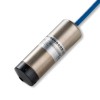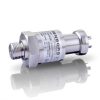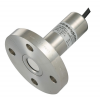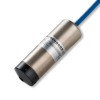Devices with marine approval certification to use on ships for measuring liquid level and converting it to an electrical signal to send to other instrumentation.
These are some examples of the applications where liquid level sensors with marine certification are used:
- Seawater ballast tank level measurement.
- Level measurement for offshore oil and gas production platforms.
- Bilge tank level monitoring.
- Water spray tank level monitoring.
- Sludge tank level monitoring.
- Laundry waste holding tank level monitoring.
- Fresh water tank level monitoring.
- Diesel oil level measurement in tanks on a ship.
- Measuring sea level to provide a signal to allow abstraction pumps to be switched off.
Products
 LMK458 Marine Approved Hydrostatic Level Transmitter - Marine approved level transmitter with 4-20mA output for measuring level of contents inside ship ballast, fuel, liquid cargo or wastewater tanks
LMK458 Marine Approved Hydrostatic Level Transmitter - Marine approved level transmitter with 4-20mA output for measuring level of contents inside ship ballast, fuel, liquid cargo or wastewater tanks DMK 458 Seawater Low Range Pressure Transmitter - Sea water corrosion resistant low range pressure transmitter for marine, ship and offshore engineering.
DMK 458 Seawater Low Range Pressure Transmitter - Sea water corrosion resistant low range pressure transmitter for marine, ship and offshore engineering.
 LMK 487 Submersible Ballast Tank and Draught Level Pressure Transmitter
LMK 487 Submersible Ballast Tank and Draught Level Pressure Transmitter LMK457 Marine Approved Level Transmitter
LMK457 Marine Approved Level Transmitter
Applications
 Floating dry dock ballast tank 14ft range 4-20mA output submersible seawater level sensor - A seawater compatible liquid level sensor for submerging in a floating dry dock ballast tank and measuring the depth over a range of 0 to 14ft from the nose cone, and sending the corresponding 4-20mA signal through the submersible cable electrical connection.
Floating dry dock ballast tank 14ft range 4-20mA output submersible seawater level sensor - A seawater compatible liquid level sensor for submerging in a floating dry dock ballast tank and measuring the depth over a range of 0 to 14ft from the nose cone, and sending the corresponding 4-20mA signal through the submersible cable electrical connection. Ferry hull draft monitoring 3 bar absolute 4-20mA output seawater pressure sensor - An absolute pressure sensor for ship use to measure seawater depth on a ferry hull draft monitoring system over a range of 0 to 3 bar abs from the G1 1/2" process connection, and sending the corresponding 4-20mA signal through the waterproof cable electrical connection.
Ferry hull draft monitoring 3 bar absolute 4-20mA output seawater pressure sensor - An absolute pressure sensor for ship use to measure seawater depth on a ferry hull draft monitoring system over a range of 0 to 3 bar abs from the G1 1/2" process connection, and sending the corresponding 4-20mA signal through the waterproof cable electrical connection. Desalination plant seawater feed tanks 5m range 4-20mA output submersible level sensor - A marine approved submersible seawater level sensor for submerging in desalination plant water tanks and measuring the depth over a range of 0 to 5m from the nose cone, and sending the corresponding 4-20mA signal through the submersible cable electrical connection.
Desalination plant seawater feed tanks 5m range 4-20mA output submersible level sensor - A marine approved submersible seawater level sensor for submerging in desalination plant water tanks and measuring the depth over a range of 0 to 5m from the nose cone, and sending the corresponding 4-20mA signal through the submersible cable electrical connection. 9m 4-20mA ship fish storage seawater storage tank submersible level sensor - A marine approved submersible liquid level sensor for submerging in a ship seawater tank for fish storage use and measuring the depth over a range of 0 to 9m from the flush diaphragm, and sending the corresponding 4-20mA signal through the submersible cable electrical connection.
9m 4-20mA ship fish storage seawater storage tank submersible level sensor - A marine approved submersible liquid level sensor for submerging in a ship seawater tank for fish storage use and measuring the depth over a range of 0 to 9m from the flush diaphragm, and sending the corresponding 4-20mA signal through the submersible cable electrical connection.
 5 barg range 4-20mA output submersible seawater pressure sensor for measuring sea level
5 barg range 4-20mA output submersible seawater pressure sensor for measuring sea level 6m deep ballast tank level transmitter with marine certificate
6m deep ballast tank level transmitter with marine certificate 100 meter IP68 sea water level transmitter with Marine & ATEX approval
100 meter IP68 sea water level transmitter with Marine & ATEX approval DNV / GL marine certified submersible seawater level transmitter for 0-3 metre depth
DNV / GL marine certified submersible seawater level transmitter for 0-3 metre depth 20 foot deep submersible salt water level transmitter for marine use
20 foot deep submersible salt water level transmitter for marine use Hydrophone array submersible 200 meter seawater depth sensor
Hydrophone array submersible 200 meter seawater depth sensor Rangeable fuel and freshwater submersible level sensor for ship tanks up to 1.6m high
Rangeable fuel and freshwater submersible level sensor for ship tanks up to 1.6m high Screw-in 2m height onboard marine vessel diesel tank base mount level sensor
Screw-in 2m height onboard marine vessel diesel tank base mount level sensor
All voyage and safety critical equipment on a ship must be certified by the same marine approval body that audited and registered the whole ship.
A marine approved device is one that has been tested and certified by a recognised body such as LR (Lloyd’s Register), GL (Germanischer Lloyd), DNV (Det Norske Veritas), ABS (American Bureau of Shipping) and CCS (China Classification Society) for use on a ship.
The marine approval process involves an initial and continuous periodic product assessment to inspect random production samples, ensure adequate production and inspection processes, procedures, documentation and quality control, and review the current product design and any future design iterations for compliance with the type approval.
A liquid level sensor is an instrument for measuring the height of a liquid and converting it to an electrical signal which is sent to other instrumentation to display, monitor, log or control the liquid level.
There are many different types of technology use to measure liquid level, there are sensors that can be mounted above the liquid such as ultrasonic or radar which bounce a sound or electromagnetic wave off the surface of the liquid and use the travel time to determine the distance from the liquid surface.
For liquid filled tanks there are sensors which can be attached externally, such as floats running up and down a liquid filled tube connected at the bottom of the tank, or a pressure sensor installed in a hole in the bottom of the tank which measures the pressure generated by gravity acting on the liquid.
Another method is to lower a probe into the tank and immerse it in the liquid such as a capacitive probe which detects the changing capacitance charge as the length of the probe is exposed to varying proportions of liquid and air, or pressure sensors which measure the pressure generated by gravity acting on the surrounding liquid.
